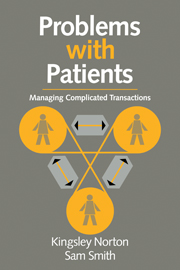Book contents
- Frontmatter
- Contents
- Foreword by Professor Paul Freeling, O.B.E.
- Preface
- Acknowledgments
- 1 Doctor–patient interaction
- 2 The clinical transaction
- 3 Interpersonal influences
- 4 The influence of past relationships
- 5 Contextual influences
- 6 Managing complicated clinical transactions
- 7 Interventions in complicated clinical transactions
- 8 Implications for the clinical setting
- 9 Implications for training
- Appendix I Clinical phenomena related to ‘problem patients’
- Appendix II Personality disorder
- References
- Index
9 - Implications for training
Published online by Cambridge University Press: 19 March 2010
- Frontmatter
- Contents
- Foreword by Professor Paul Freeling, O.B.E.
- Preface
- Acknowledgments
- 1 Doctor–patient interaction
- 2 The clinical transaction
- 3 Interpersonal influences
- 4 The influence of past relationships
- 5 Contextual influences
- 6 Managing complicated clinical transactions
- 7 Interventions in complicated clinical transactions
- 8 Implications for the clinical setting
- 9 Implications for training
- Appendix I Clinical phenomena related to ‘problem patients’
- Appendix II Personality disorder
- References
- Index
Summary
Introduction
At pre-clinical, clinical and postgraduate levels, medical training could incorporate teaching on: the concept of straightforward and complicated clinical transactions; an understanding of the influence of personality and unconscious, as opposed to conscious, motivation of doctor and patient in their clinical interaction; the influence of past relationships with authority figures upon the attitudes and behaviour of doctor and patient as they transact; the influence of the psychological and social context (including the clinical setting itself) of doctor and patient on the clinical transaction; and the use of transaction and systems windows, as well as other interventions. This is because, particularly in primary care practice, it has long been acknowledged that diagnosis should be couched not only in physical but in psychological and social terms (Royal College of General Practitioners, 1972) and that the psychological component of the consultation is fundamental (Pendleton, 1983).
The work of Michael and Enid Balint (see Balint, 1957; Balint and Norrell, 1973), emphasising a deeper level of diagnosis, has influenced the practice of many doctors and, increasingly, doctors’ attitudes to their patients form an important discriminator between ‘good’ and ‘bad’ doctors (Kilpatrick, 1993). It has also been recognised that doctors’ interventions exert a psychological effect on patients that can influence the outcome of the clinical transactions not only in the short term but also in the long term (Freeling and Harris, 1984).
- Type
- Chapter
- Information
- Problems with PatientsManaging Complicated Transactions, pp. 144 - 154Publisher: Cambridge University PressPrint publication year: 1994



